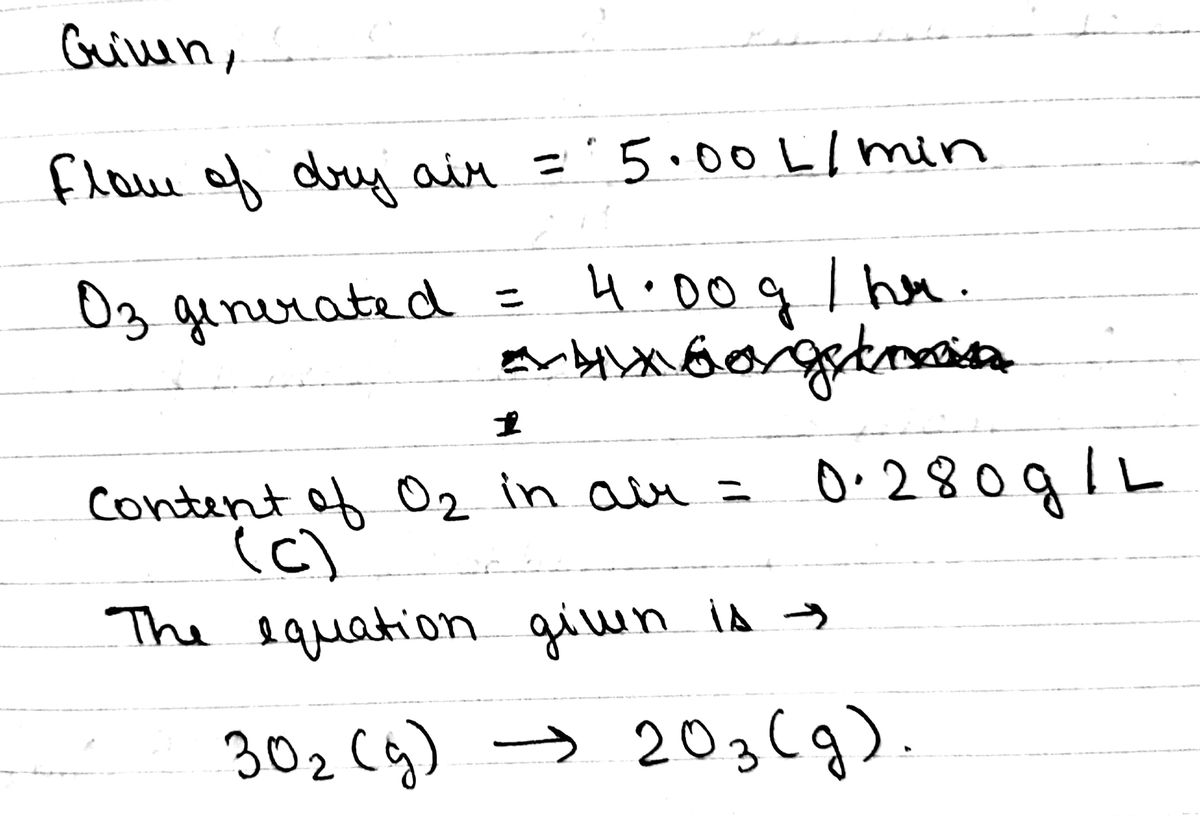Some indoor air-purification systems work by converting a little of the oxygen in the air to ozone, which oxidizes mold and mildew spores and other biological air pollutants. The chemical equation for the ozone generation reaction is: It is claimed that one such system generates 4.00 g O3 per hour from dry air passing through the purifier at a flow of 5.00 L/min. If one liter of indoor air contains 0.280 g of O2, what mole fraction of O2 is converted to O3 by the air purifier? What is the percent yield of the ozone generation reaction?
Some indoor air-purification systems work by converting a little of the oxygen in the air to ozone, which oxidizes mold and mildew spores and other biological air pollutants. The chemical equation for the ozone generation reaction is: It is claimed that one such system generates 4.00 g O3 per hour from dry air passing through the purifier at a flow of 5.00 L/min. If one liter of indoor air contains 0.280 g of O2, what mole fraction of O2 is converted to O3 by the air purifier? What is the percent yield of the ozone generation reaction?
Chemistry
10th Edition
ISBN:9781305957404
Author:Steven S. Zumdahl, Susan A. Zumdahl, Donald J. DeCoste
Publisher:Steven S. Zumdahl, Susan A. Zumdahl, Donald J. DeCoste
Chapter1: Chemical Foundations
Section: Chapter Questions
Problem 1RQ: Define and explain the differences between the following terms. a. law and theory b. theory and...
Related questions
Question
Some indoor air-purification systems work by converting a little of the oxygen in the air to ozone, which oxidizes mold and mildew spores and other biological air pollutants. The chemical equation for the ozone generation reaction is:
It is claimed that one such system generates 4.00 g O3 per hour from dry air passing through the purifier at a flow of 5.00 L/min.
If one liter of indoor air contains 0.280 g of O2, what mole fraction of O2 is converted to O3 by the air purifier?
What is the percent yield of the ozone generation reaction?

Transcribed Image Text:30,(g) –→ 20,(g)
Expert Solution
Step 1

Trending now
This is a popular solution!
Step by step
Solved in 3 steps with 3 images

Knowledge Booster
Learn more about
Need a deep-dive on the concept behind this application? Look no further. Learn more about this topic, chemistry and related others by exploring similar questions and additional content below.Recommended textbooks for you

Chemistry
Chemistry
ISBN:
9781305957404
Author:
Steven S. Zumdahl, Susan A. Zumdahl, Donald J. DeCoste
Publisher:
Cengage Learning

Chemistry
Chemistry
ISBN:
9781259911156
Author:
Raymond Chang Dr., Jason Overby Professor
Publisher:
McGraw-Hill Education

Principles of Instrumental Analysis
Chemistry
ISBN:
9781305577213
Author:
Douglas A. Skoog, F. James Holler, Stanley R. Crouch
Publisher:
Cengage Learning

Chemistry
Chemistry
ISBN:
9781305957404
Author:
Steven S. Zumdahl, Susan A. Zumdahl, Donald J. DeCoste
Publisher:
Cengage Learning

Chemistry
Chemistry
ISBN:
9781259911156
Author:
Raymond Chang Dr., Jason Overby Professor
Publisher:
McGraw-Hill Education

Principles of Instrumental Analysis
Chemistry
ISBN:
9781305577213
Author:
Douglas A. Skoog, F. James Holler, Stanley R. Crouch
Publisher:
Cengage Learning

Organic Chemistry
Chemistry
ISBN:
9780078021558
Author:
Janice Gorzynski Smith Dr.
Publisher:
McGraw-Hill Education

Chemistry: Principles and Reactions
Chemistry
ISBN:
9781305079373
Author:
William L. Masterton, Cecile N. Hurley
Publisher:
Cengage Learning

Elementary Principles of Chemical Processes, Bind…
Chemistry
ISBN:
9781118431221
Author:
Richard M. Felder, Ronald W. Rousseau, Lisa G. Bullard
Publisher:
WILEY